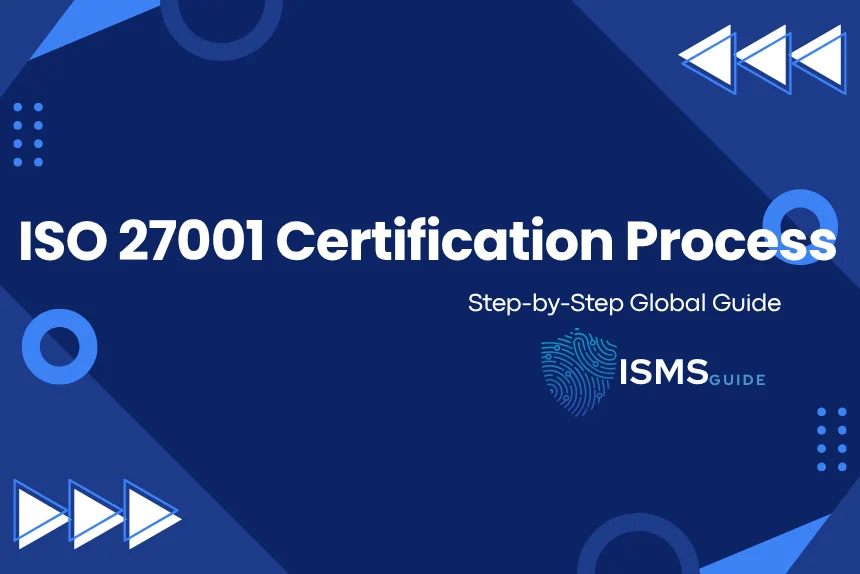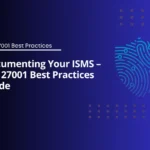Find out about the global process, requirements, and step-by-step instructions for getting your Information Security Management System (ISMS) certified under ISO 27001:2022.
Table Of Content
- ISO 27001 Certification Global
- Eligibility & Prerequisites
- The Global Process for ISO 27001 Certification Step by Step
- Step 1: Readiness Assessment / Gap Analysis
- Step 2: Write it down and put it into action
- Step 3: Management Review and Internal Audits
- Step 4: Stage 1 Certification Audit (Review of Documents)
- Step 5: Stage 2 Certification Audit (Verification of Implementation)
- Step 6: Issuing a Certificate and Taking Corrective Actions
- Choosing a Certification Body
- Keeping your ISO 27001 certification
- Common Problems and Solutions
ISO 27001 Certification Global
ISO 27001 certification is the world standard for Information Security Management Systems (ISMS). Companies all over the world seek ISO 27001 certification global to show that they care about protecting information, gain the trust of customers, and follow the rules. Getting certified shows that your business handles sensitive information in a planned way and lowers risks in a smart way.
Certification helps global companies, multinational corporations, and small-to-medium businesses by making their brands more trustworthy, making their operations more resilient, and lowering the risks of cyberattacks. Following ISO 27001 best practices during the certification process makes sure that your company is ready for an audit and meets global standards.
The most recent version of the international standard for ISMS is ISO 27001:2022. Some of the most important changes are:
- Annex A has streamlined control sets that focus on new cybersecurity threats.
- Focus on thinking about risks and the context of the organization
- New advice on how to keep an eye on things, measure them, and keep getting better
Organizations that want to get certified need to understand these updates. ISO 27001 certification global checks that your ISMS meets these global standards and does a good job of managing information security risks.
Eligibility & Prerequisites
Before applying for ISO 27001 certification global, companies should make sure that:
- Set the ISMS Scope: List all the business areas, processes, and information assets that need to be covered.
- Risk Assessment & Treatment: Conduct comprehensive risk assessments and implement risk treatment plans.
- Documented Policies and Procedures: Make sure you have the right paperwork, like the Information Security Policy, the SoA, and the operational procedures.
- Management Commitment: The top management must be fully behind the implementation and ongoing improvement of ISMS.
Before hiring a certification body, a readiness assessment or gap analysis can help find problems, which makes it more likely that the audit will go well.
The Global Process for ISO 27001 Certification Step by Step
To get ISO 27001 certification worldwide, you usually have to go through a structured six-step process:

Step 1: Readiness Assessment / Gap Analysis
Check how well your current information security meets the standards set by ISO 27001. Find holes in the documentation, processes, or controls. This step helps put corrective actions in order before the formal audit.
Step 2: Write it down and put it into action
Get the necessary paperwork ready, such as
Prepare required documentation including:
- The ISMS scope
- Policies and procedures for information security
- Plans for treatment and risk assessments
- Statement of Applicability (SoA)
At the same time, put controls in place throughout the organization to deal with the risks that have been found. Standard templates can make paperwork easier and make sure that everything is the same.
Step 3: Management Review and Internal Audits
Do internal audits to make sure you are following the rules of ISO 27001. Management should look over the audit results and make sure that the right steps are being taken. This makes sure that the ISMS works well before the outside audit.
Step 4: Stage 1 Certification Audit (Review of Documents)
The certification body checks your ISMS documentation to make sure it is complete and follows ISO 27001:2022. This step makes sure that everything is ready for the implementation audit.
Step 5: Stage 2 Certification Audit (Verification of Implementation)
Auditors look at how well controls and procedures are being followed. Interviews, observations, and document reviews are used to gather proof of operational effectiveness. Any problems that don’t follow the rules are found so that they can be fixed.
Step 6: Issuing a Certificate and Taking Corrective Actions
Fix any problems that were found in Stage 2. Once the certification body is happy, it gives ISO 27001 certification to the whole world. This certification is usually good for three years, but it can be checked every year.
Choosing a Certification Body
Choosing the right certification body is very important:
- Internationally accredited bodies are more widely recognized, while local bodies may be cheaper.
- Accreditation: Make sure that the body is accredited by a well-known organization, like UKAS, ANAB, or something similar.
- Audit Expertise: Experienced auditors can give you useful feedback that goes beyond just making sure you’re following the rules.
Choosing the right certification makes sure that ISO 27001 is accepted and respected around the world.
Keeping your ISO 27001 certification
Getting ISO 27001 certified is not something you can do once. To keep it up, you need to:
- Surveillance Audits: These are done every year to make sure that rules are still being followed.
- Continuous Improvement: Deal with new risks, update controls, and change documents as needed.
- Recertification: Every three years, a full audit is needed to keep the certification valid.
Taking a proactive approach makes sure that your ISMS stays in line with global security standards and your company’s goals.
Common Problems and Solutions
Companies that want to get ISO 27001 certification around the world often run into:
- Incomplete Documentation: This risk is lessened by using standard templates and checklists.
- Not enough involvement from management: For the ISMS to work, leadership needs to support it.
- Scope Creep: To keep resources from getting too full, make sure the ISMS boundaries are clear.
- Audit Readiness: Doing regular internal audits and mock assessments makes you more ready.
How to Succeed:
- Use ISO 27001 best practices during the whole implementation process.
- Teach staff about ISMS processes all the time.
- Keep documentation that is version-controlled.
- Keep an eye on new risks and make sure the ISMS is up to date.





